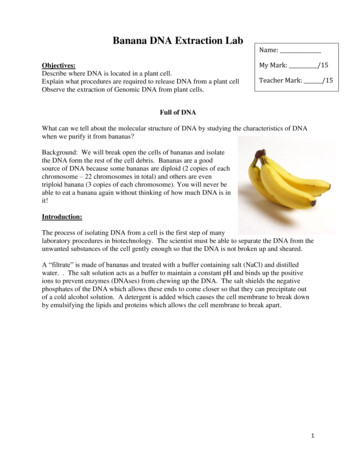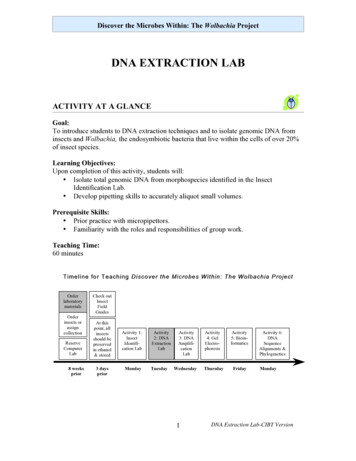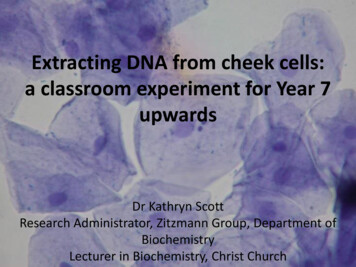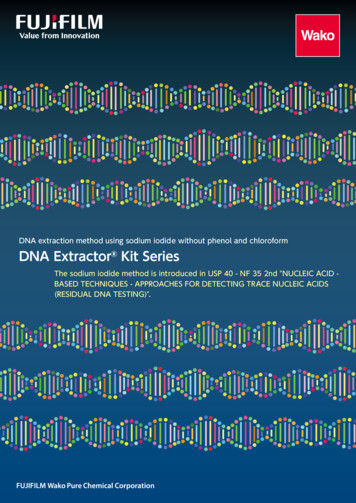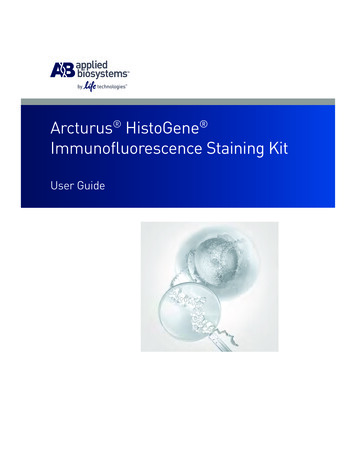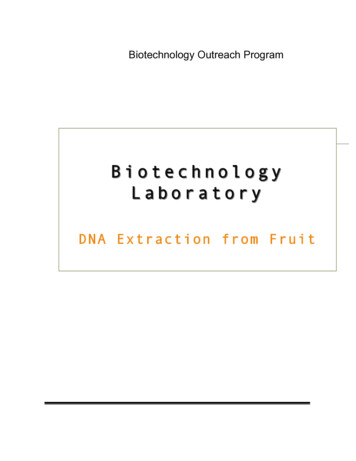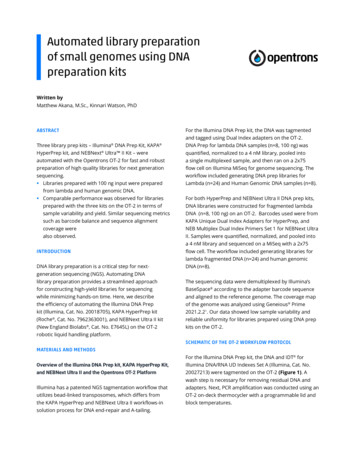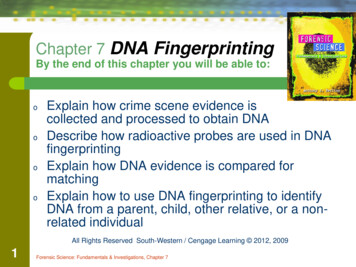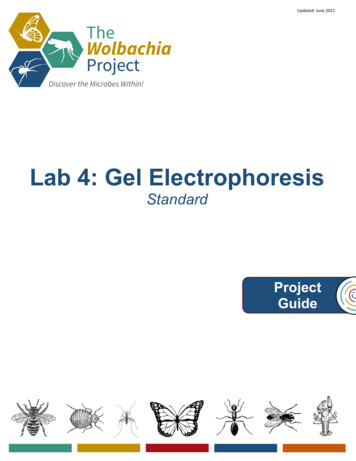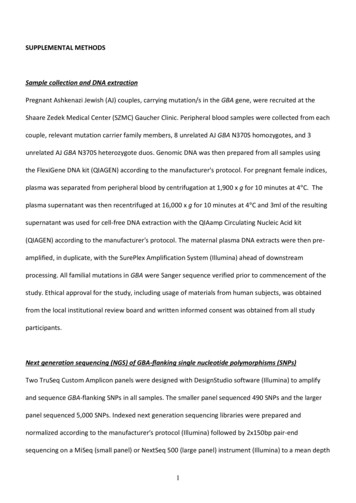
Transcription
SUPPLEMENTAL METHODSSample collection and DNA extractionPregnant Ashkenazi Jewish (AJ) couples, carrying mutation/s in the GBA gene, were recruited at theShaare Zedek Medical Center (SZMC) Gaucher Clinic. Peripheral blood samples were collected from eachcouple, relevant mutation carrier family members, 8 unrelated AJ GBA N370S homozygotes, and 3unrelated AJ GBA N370S heterozygote duos. Genomic DNA was then prepared from all samples usingthe FlexiGene DNA kit (QIAGEN) according to the manufacturer's protocol. For pregnant female indices,plasma was separated from peripheral blood by centrifugation at 1,900 x g for 10 minutes at 4 C. Theplasma supernatant was then recentrifuged at 16,000 x g for 10 minutes at 4 C and 3ml of the resultingsupernatant was used for cell-free DNA extraction with the QIAamp Circulating Nucleic Acid kit(QIAGEN) according to the manufacturer's protocol. The maternal plasma DNA extracts were then preamplified, in duplicate, with the SurePlex Amplification System (Illumina) ahead of downstreamprocessing. All familial mutations in GBA were Sanger sequence verified prior to commencement of thestudy. Ethical approval for the study, including usage of materials from human subjects, was obtainedfrom the local institutional review board and written informed consent was obtained from all studyparticipants.Next generation sequencing (NGS) of GBA-flanking single nucleotide polymorphisms (SNPs)Two TruSeq Custom Amplicon panels were designed with DesignStudio software (Illumina) to amplifyand sequence GBA-flanking SNPs in all samples. The smaller panel sequenced 490 SNPs and the largerpanel sequenced 5,000 SNPs. Indexed next generation sequencing libraries were prepared andnormalized according to the manufacturer's protocol (Illumina) followed by 2x150bp pair-endsequencing on a MiSeq (small panel) or NextSeq 500 (large panel) instrument (Illumina) to a mean depth1
of at least 500x or 3800x for genomic and plasma DNA samples, respectively. After sequencing runs, thedata were aligned to target sequences on the human reference genome (hg19) using MiSeq Reportersoftware (Illumina) for the small panel or the TruSeq Amplicon v1.1 app on BaseSpace(https://basespace.illumina.com/) for the large panel. Genotyping data was extracted from eachalignment using the SAMtools mpileup program to yield sample-specific SNP genotype profiles and thenthe SNPs were annotated by snpEff with dbSNP138 (small panel) or dbSNP141 (large panel). Theseprofiles were then combined into single family-specific .csv files using in-house software so as tofacilitate familial and fetal linkage analysis (see below). Prior to linkage analysis, non-GBA flanking SNPcalls and SNP calls on heavily self-chained genomic segments were removed. Genomic DNA SNPgenotype calls were categorized into one of 3 distinct classifications based on the percentage of nonreference genome allele (B allele) sequencing reads at each locus: homozygote reference allele (AA; 0%20% B allele reads); homozygote non-reference allele (BB; 80%-100% B allele reads); or heterozygote(AB; 30%-70% B allele reads). Any loci that did not meet these classification criteria were excluded fromfurther downstream analysis. As a rule, parental haplotypes were constructed with SNPs for which theparent was heterozygous and at least one of his/her first degree relatives was homozygous.Construction of consensus AJ N370S and familial haplotypesThe initial consensus AJ N370S GBA-flanking haplotype was constructed by performing homozygositymapping with custom SNP small panel NGS datasets from 7 unrelated AJ N370S homozygotes (14 N370Schromosomes). Subsequently, 6 more AJ N370S haplotypes were derived from linkage analysis on SNPNGS datasets from 6 unrelated AJ N370S mutation carrier duos. Each linkage-based N370S haplotypewas then crossed with the consensus sequence derived from homozygosity mapping to identifyinconsistencies. These sequence discrepancies were then used to mark consensus AJ N370S founderhaplotype cut-offs (based on 20 N370S chromosomes, altogether, after the completion of all data2
intersections). The larger consensus AJ N370S GBA-flanking haplotype was constructed by performinghomozygosity mapping with custom SNP large panel NGS datasets from 8 unrelated AJ N370Shomozygotes (16 N370S chromosomes). Subsequently, 12 more AJ N370S haplotypes were derived fromlinkage analysis on SNP NGS datasets from 12 unrelated AJ N370S mutation carrier duos. The finalconsensus AJ N370S founder haplotype cut-offs (based on 28 N370S chromosomes, altogether, after thecompletion of all data intersections) were then set as described above regarding the initial consensushaplotype construct.Identification of fetal alleles in maternal plasma DNAIn order to construct credible small fetal haplotypes (composed of 5 SNPs) with the small SNPsequencing panel, plasma DNA samples were sequenced in duplicate at high depth ( 3,000x meancoverage) so as to augment statistical confidence in each individual fetal SNP genotype call. In all, fourdifferent combinations of parental SNP genotypes were analyzed in plasma DNA: A) Error rateinformative (father and mother [of the fetus] both homozygote "AA"); B) Dosage informative (father andmother homozygote for opposite alleles); C) Paternal haplotype informative (father heterozygote andmother homozygote); and D) Maternal haplotype informative SNPs (mother heterozygote and fatherhomozygote). Error rate informative SNPs measured the sequencing error rate in plasma DNA samplesby assessing the appearance of biologically impossible SNP reads. At 1000x read depth, error rates of0.6% /- 0.6% were measured in plasma DNA samples. Dosage informative SNPs (denoted heretofore as"SNP I") measured the paternal portion of fetal plasma DNA by determining the fraction of paternalalleles per maternal alleles. These SNPs also confirmed the presence of fetal DNA in maternal plasma.Paternal haplotype informative SNPs (denoted heretofore as "SNP II") feature a unique nucleotide in thefetus' father that is not present in the maternal genotype. When identified in maternal plasma DNA, thepaternal unique allele is expected to comprise the same fraction as those of paternal alleles in dosage3
informative SNPs. In general, the paternal haplotype of the fetus was deduced wherever the father'sunique SNP II allele was identified in one of 2 plasma DNA replicates (at a SNP position with 1000xsequencing depth) with relatively high frequency ( 2σ from the mean sequencing error rate asdetermined from error rate informative SNPs) in maternal plasma DNA. The computedsensitivity/specificity scores for this method are provided as a function of the number of uniquepaternal SNPs identified in the fetus (see Supplemental Table 1).For plasma DNA samples with high fetal dosage ( 30% paternal fetal fraction), the paternal haplotype inthe fetus was also deduced from non-unique SNP II alleles (with 500x coverage) for which there wereno discrepancies between replicate fetal haplotype calls. The computed sensitivity/specificity scores forthis method are provided as a function of the number of non-unique paternal SNPs identified in thefetus (see Supplemental Table 2). Maternal haplotype informative SNPs (denoted heretofore as "SNPIII") were used to determine the maternal haplotype in the fetus at 1000x sequencing coverage. TheseSNPs indicated a heterozygous fetal genotype when allele-allele ratios were balanced, and ahomozygous fetal genotype when these ratios were imbalanced by a number 3σ from the meansequencing error rate (as determined from error rate informative SNPs). Depending on the father'shomozygous allele, the maternal fetal allele was deduced based on the presence or absence of skewing( 50% non-reference nucleotide skewed representation if the father was homozygote A [for thereference nucleotide]; 50% non-reference nucleotide skewed if the father was homozygote B [for thenon-reference nucleotide]) in maternal heterozygous SNP III loci on both plasma DNA replicates. Thecomputed sensitivity/specificity scores for this method are provided as a function of the number ofmaternal haplotyped SNPs identified in the fetus (see Supplemental Table 3). All parental SNPcombinations that did not fall within the above guidelines were not utilized in this study.In order to construct large fetal haplotypes (composed of 5 SNPs) with the large SNP sequencing panel,plasma DNA samples were analyzed as above with the following modifications. Error rate informative4
SNPs indicated a 1% error rate at read depths exceeding 100x. Accordingly, paternal haplotypeinformative and maternal haplotype informative SNPs were assessed from a minimum read depth of100 whereupon only skewing exceeding 1% B-allele frequency in plasma DNA with respect to maternalDNA (at a particular locus) was considered significant enough for incorporation into the fetal haplotype.This filter was applied so as to reduce genotyping errors emerging from either sequencing error and/oroff-target sequence contamination.Ultimately, fetal diagnosis was achieved after comparing the paternal and maternal cell-free fetal DNA(cffDNA) haplotypes with family-based and/or N370S consensus or near consensus haplotypes asrelevant. Altogether, the entire noninvasive NGS-based prenatal test, from blood sample processing tofetal diagnosis, was completed in 5 work days. In addition, all diagnoses were confirmed by post-natalgenetic testing. For family 1, allelic inheritance of the N370S mutation was further confirmed bypostnatal linkage analysis with short tandem repeat (STR) markers.5
Supplemental Table 1. Simulated sensitivity/specificity for unique paternal allele diagnosisNo. SNPs in fetal %10100.00%A. The formula for these calculations was as follows: [1-([(0.5)(er)] [(0.5)(er)])n] where "n" represents the number of SNPs in the fetal haplotype and "er"represents the chance (which is 5%) of unique paternal allele detection at 2σ from the sequencing error rate as determined from error rate informative SNPsequences (see Supplemental Methods). For 1 to 4 SNP haplotypes, a 0.03% correction was applied to account for the sex-specific male recombination rate inthe /- 250kb genomic region surrounding GBA according to reference (20) but if longer haplotypes do not flank the mutation, this correction should continueto be applied.
Supplemental Table 2. Simulated sensitivity/specificity for non-unique paternal allele diagnosisNo. SNPs in fetal 0100.00%A. The formula for these calculations was as follows: [1-([(0.5)(1-er)]2)n] where "n" represents the number of SNPs in the fetal haplotype and "er" represents thechance (which is 5%) of unique paternal allele detection at 2σ from the sequencing error rate as determined from error rate informative SNP sequences (seeSupplemental Methods). For 1 to 4 SNP haplotypes, a 0.03% correction was applied to account for the sex-specific male recombination rate in the /- 250kbgenomic region surrounding GBA according to reference (20) but if longer haplotypes do not flank the mutation, this correction should continue to be applied.
Supplemental Table 3. Simulated sensitivity/specificity for maternal allele diagnosisNo. SNPs in fetal 100.00%A. The formula for these calculations was as follows: [1-[(0.5)2]n] where "n" represents the number of SNPs in the fetal haplotype. For 1 to 4 SNP haplotypes, a0.07% correction was applied to account for the sex-specific female recombination rate in the /- 250kb GBA region according to reference (20) but if longerhaplotypes do not flank the mutation, this correction should continue to be applied.
Supplemental Table 4. Parental family-based haplotype informationFamilyPaternal familial haplotype dataPaternalgenotypeMaternal familial haplotype dataPaternal familyGenotype ofNo. of SNPsmember usedpaternal familyin linkedfor linkagememberhaplotypeMaternalgenotypeMaternal familyGenotype ofNo. of SNPsmember used formaternalin linkedlinkagefamily 11Abbreviations: WT, wild type; N/A, not applicable
Supplemental Table 5. Consensus Ashkenazi Jewish N370S founder 224404155224417dbSNP IDREFALTconsensus AJ N370S 81495640rs12407919rs186289485rs1045253GBA 3' UTRBGBA 5' AAAAAAAAAAAABAAAAAAAAAAAAAAAAAAAAAAAAAAAA1
AAAAAAAAAAAAAAAAAAAAAAAAAAAAAAAAAAAAAAAAAAAAA
AAAA
GTTTCGTGA.A.A.C.ABAAAAAAAAABAABAAAbbreviations: Ch, chromosome; REF, reference nucleotide (dbSNP Build 138); ALT, alternate (non-reference)nucleotide (dbSNP Build 138)A. For the consensus AJ N370S haplotype: "A" dbSNP reference nucleotide; "B" dbSNP non-referencenucleotideB. The region shaded in gray indicates GBA gene 5' and 3' locus boundaries4
Supplemental Table 6. Identification of the paternal allele in the family 1 fetus (small panel)Variant dataChPosition(hg19)AdbSNP IDDFM(bps)BPGTMGTBFLC(%)plasma DNA repplasma DNA rep1-11-2RD (x)BAFD(%)RD 205634N370S-----------67.7Abbreviations: Ch, chromosome; DFM, distance from mutation; PGT, paternal genotype; MGT, maternal genotype; FL, fetal load; rep, replicate plasma DNA sample, RD, sequencingread depth; BAF, B-allele frequency; PHiF, paternal haplotype in fetus; PFB N370S, paternal family-based N370S-linked haplotype; FAI, fetal allele identity; DPAiF, diagnosed paternalallele in fetus.A. dbSNP ID or GBA mutation (red lettering)B. For parental genotypes "AA" homozygote dbSNP reference allele; "BB" homozygote dbSNP non-reference allele; "AB" heterozygoteC. Fetal load is 2x(mean paternal fetal fraction) as determined from SNP I and/or SNP II data (see Supplemental Methods)D. B-allele frequency (BAF) is the % frequency of (B-allele reads)/(total read depth (RD)) at the indicated nucleotide position; bold BAF data was used to construct "PHiF"1
E. The paternal fetal haplotype (PHiF) was determined from SNP II data (as described in Supplemental Methods); the paternal N370S-linked haplotype (PFB N370S) wasdetermined from family-based linkage analysis; the N370S consensus haplotype (N370S cons) was derived according to Figure 2. An "-" indicates that no haplotype data wasavailable at the given position. Bold alleles were used for diagnosis of the paternal allele in the fetus ("DPAiF").F. Fetal allele identity (FAI) was determined by comparing the "PHiF" haplotype to the "PFB N370S" haplotype2
Supplemental Table 7. Preliminary summary of noninvasive prenatal diagnosis with validationplasma DNA sample typegenotypePaternal haplotype in fetusBased ernal haplotype in fetusBased onBased pe?ValidationBased 370SYESNOPostnatal cord bloodAbbreviation: N/A, not applicableA. Due to paternal homozygosity in consensus N370S haplotype region
Supplemental Table 8. Identification of the maternal allele in the family 1 fetus (small panel)Variant dataChPosition(hg19)AdbSNP IDDFM(bps)BPGTMGTBFLC(%)plasma DNA repplasma DNA rep1-11-2RD (x)BAFD(%)RD BN370S67.71
N370SAbbreviations: MHiF, maternal haplotype in fetus; MFB N370S, maternal family-based N370S-linked haplotype; N370S cons, consensus N370S haplotype, FAI, fetal allele identity;DMAiF, diagnosed maternal allele in fetus; other abbreviations are the same as in Supplemental Table 6.A. dbSNP ID or GBA mutation (red lettering)B. For parental genotypes "AA" homozygote dbSNP reference allele; "BB" homozygote dbSNP non-reference allele; "AB" heterozygoteC. Fetal load is 2x(mean paternal fetal fraction) as determined from SNP I and/or SNP II data (see Supplemental Methods)D. B-allele frequency is the % frequency of (B-allele reads)/(total read depth (RD)) at the indicated nucleotide positionE. The maternal fetal haplotype (MHiF) was determined from SNP III data (as described in Supplemental Methods); the maternal N370S-linked haplotype (MFB N370S) wasdetermined from family-based linkage analysis; the N370S consensus haplotype (N370S cons) was derived according to Figure 2. An "-" indicates that no haplotype data wasavailable at the given position. Bold alleles were used for diagnosis of the maternal allele in the fetus ("DMAiF").F. Fetal allele identity (FAI) was determined by comparing the "MHiF" haplotype to either the " MFB N370S" and/or "N370S cons" haplotypes2
Supplemental Table 9. Identification of the maternal allele in the family 2 fetus (small panel)Variant dataChPosition(hg19)AdbSNP 424065rs11264375-218,431AAABBAbbreviations and footnotes are the same as in Supplemental Table 8.FLC(%)5.7plasma DNA repplasma DNA rep2-12-2RD (x)BAFD(%)RD AN370S794527.3655230.6AAN370S
Supplemental Table 10. Consensus Ashkenazi Jewish N370S founder ,206,341155,206,363155,206,440155,208,019dbSNP IDREFALTconsensus AJ N370S AA1
2AAAAAAAAAAAAAAAAAAAAAAAAAAAAAAAAAAAAAAAAAAAAAAAAA
AAAAAAAAAAAAAAAAAAAAAAAAAAAAAAAAAAAAAAAAAAAAAABA
AAAAAA
AAAAABAAAAAAAAAAAAAAAAAAAAAAAAAAAAAAAA
AAAAAAAAAABAABAAAAAABAABAABABABAAAAAAAAAABAAA
.A.AAABABAABAAAAAbbreviations: Ch, chromosome; REF, reference nucleotide (dbSNP Build 141); ALT, alternate (non-reference)nucleotide (dbSNP Build 141)A. For the consensus AJ N370S haplotype: "A" dbSNP reference nucleotide; "B" dbSNP non-referencenucleotideB. The region shaded in gray indicates GBA intragenic loci7
Supplemental Table 11. Parental family-based haplotype i
Two TruSeq Custom Amplicon panels were designed with DesignStudio software (Illumina) to amplify and sequence GBA-flanking SNPs in all samples. The smaller panel sequenced 490 SNPs and the larger panel sequenced 5,000 SNPs. Indexed next generation sequencing libraries were prepared and normalized according to the manufacturer's protocol (Illumina) followed by 2x150bp pair -end sequencing on a .
